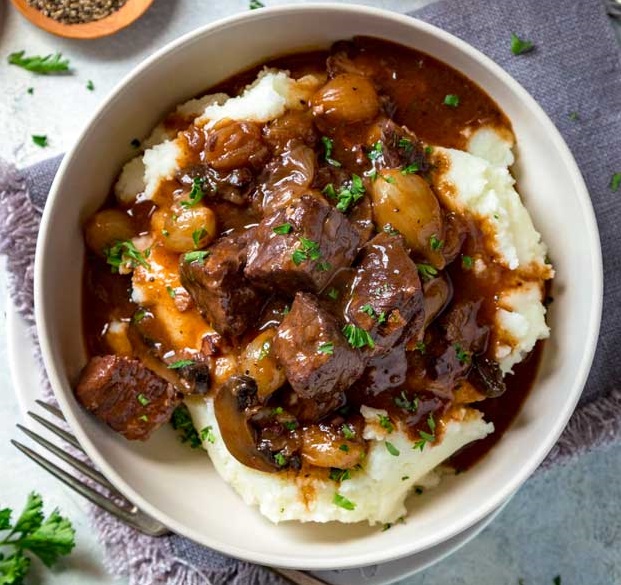Beef stews like boeuf bourguignon and goulash will never go out of style. Because tougher, collagen-rich cuts like chuck or brisket, which are usually used for stew, take up to an hour to break down into tender, flavorful perfection, stews are great for winters when it’s very cold outside. But all that beef needs a lot of liquid to cook, and sometimes you have too much. That means you’ll probably want to thicken it up before serving.
Beef bourguignon is a classic French stew that is known and loved for its rich flavorful gravy-like sauce. When properly made the sauce should have a silky, luxurious texture that coats the tender beef and vegetables. However, sometimes the sauce can turn out too thin and watery. So how can you achieve that ideal thickened consistency for beef bourguignon?
In this guide, we’ll explain several simple and effective methods for thickening up the sauce for beef bourguignon, to get it just right every time.
The Importance of Sauce Thickness
The hallmark of a properly made beef bourguignon is a sauce that is nicely thickened to be almost gravy-like. This allows the sauce to cling to the ingredients and impart deep flavor in every bite. An ideal thickness also gives the dish a pleasant, velvety texture in the mouth.
On the other hand, if the sauce turns out too thin and watery, it fails to coat and flavor properly. The overall taste will be weak and diluted, and the texture unappealingly runny. That’s why learning how to adjust the thickness is key.
What Causes a Thin Sauce?
There are a few common reasons that beef bourguignon sauce might turn out too thin:
- Too much liquid added during cooking
- Insufficient reduction during braising
- Lack of starch to bind and thicken
- Fat not emulsified into the liquid
Fortunately, these issues are all easy to correct by using one of several quick thickening methods.
How to Thicken Beef Bourguignon Sauce
If your completed beef bourguignon still seems too thin or watery, there are a few simple fixes
Simmer to Reduce Liquid
The easiest solution is to simply simmer the stew, uncovered, for 10-15 minutes. This will allow some of the excess liquid to cook off, naturally reducing the sauce down to a thicker consistency. Stir occasionally to prevent sticking or burning.
Mix in a Flour Slurry
Making a quick flour slurry is another common way to thicken up the sauce. In a small bowl, whisk together 1-2 Tbsp flour and 1/4 cup stew liquid until smooth. Pour this back into the pot, stir well, and simmer for 1-2 minutes to activate thickening.
Blend in Cold Butter
Cut 1-2 Tbsp cold butter into pieces and stir into the simmering stew. The butter will melt and emulsify into the sauce, giving it more body and viscosity for thicker texture.
Sprinkle with Flour
Stirring in a sprinkling of 1-2 Tbsp flour directly into the stew can also help bind up the excess moisture. Just be sure to cook briefly afterward so the raw flour taste cooks out.
Add Breadcrumbs or Rice
For a natural thickening agent, add 2-3 Tbsp dried breadcrumbs or cooked rice directly to the stew. Simmer for 5 minutes, stirring frequently, for the starches to release and absorb liquid.
Tips for Preventing a Thin Sauce
To avoid having to thicken the sauce after the fact, keep these tips in mind when making beef bourguignon:
- Reduce wine sufficiently before adding to stew
- Start with just enough liquid to barely cover ingredients
- Add extra carrots or mushrooms – they release natural starch
- Sprinkle meat with flour before browning to create fond for sauce
- Simmer uncovered at end to reduce remaining liquid
- Skim excess fat from surface periodically
Serving Suggestions
Once you’ve adjusted the sauce to the perfect velvety thickness, serve your beef bourguignon over:
- Buttered egg noodles – rich, comforting classic
- Mashed potatoes – for soaking up every drop of that luscious gravy
- Fresh bread – to dip into the phenomenal sauce
- Rice pilaf – balances the richness nicely
Any way you serve it, a properly thickened beef bourguignon is the ultimate cold weather comfort food. Get that sauce just right, and enjoy!

Why Should You Thicken Stew?
What kind of stew are you making? Whether it’s French or American, the meat and vegetables will almost certainly be covered in some kind of liquid. In her book Mastering the Art of French Cooking, Julia Child writes that the famous boeuf bourguignon needs about six cups of liquid, which should be made up of about equal parts red wine and beef stock.
Beef stews like boeuf bourguignon and goulash will never go out of style. Because tougher, collagen-rich cuts like chuck or brisket, which are usually used for stew, take up to an hour to break down into tender, flavorful perfection, stews are great for winters when it’s very cold outside. But all that beef needs a lot of liquid to cook, and sometimes you have too much. That means you’ll probably want to thicken it up before serving.
Stew Recipes : How to Thicken Beef Stew Gravy
FAQ
What do I do if my beef stew is too watery?
How do I thicken beef bourguignon without flour?
Is it better to thicken beef stew with flour or cornstarch?
